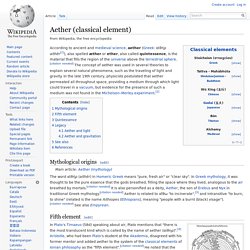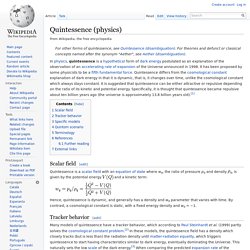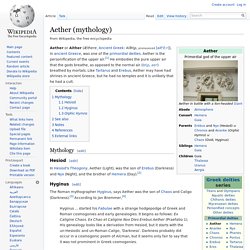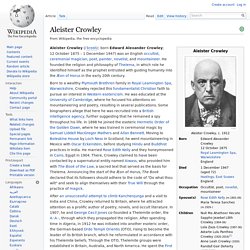

Aether (classical element) According to ancient and medieval science, aether (Greek: αἰθήρ aithēr[1]), also spelled æther or ether, also called quintessence, is the material that fills the region of the universe above the terrestrial sphere.

[citation needed] The concept of aether was used in several theories to explain several natural phenomena, such as the traveling of light and gravity. In the late 19th century, physicists postulated that aether permeated all throughout space, providing a medium through which light could travel in a vacuum, but evidence for the presence of such a medium was not found in the Michelson–Morley experiment.[2] Medieval concept of the cosmos. Quintessence (physics) In physics, quintessence is a hypothetical form of dark energy postulated as an explanation of the observation of an accelerating rate of expansion of the Universe announced in 1998.

It has been proposed by some physicists to be a fifth fundamental force. Quintessence differs from the cosmological constant explanation of dark energy in that it is dynamic, that is, it changes over time, unlike the cosmological constant which always stays constant. It is suggested that quintessence can be either attractive or repulsive depending on the ratio of its kinetic and potential energy. Specifically, it is thought that quintessence became repulsive about ten billion years ago (the universe is approximately 13.8 billion years old).[1] Michelson–Morley experiment. Figure 1.

Michelson and Morley's interferometric setup, mounted on a stone slab and floating in a pool of mercury. The Michelson–Morley experiment was published in 1887 by Albert A. Michelson and Edward W. Morley and performed at what is now Case Western Reserve University in Cleveland, Ohio.[1] It attempted to detect the relative motion of matter through the stationary luminiferous aether ("aether wind"). Akashic records. Background[edit] Akasha is a Sanskrit word meaning "sky", "space" or "æther", and it entered the language of theosophy through H.

P. Aether (mythology) Aether or Aither (Æthere, Ancient Greek: Αἰθήρ, pronounced [aitʰɛ̌ːr]), in ancient Greece, was one of the primordial deities.

Aether is the personification of the upper air.[1] He embodies the pure upper air that the gods breathe, as opposed to the normal air (ἀήρ, aer) breathed by mortals. Like Tartarus and Erebus, Aether may have had shrines in ancient Greece, but he had no temples and it is unlikely that he had a cult. Hyginus ... started his Fabulae with a strange hodgepodge of Greek and Roman cosmogonies and early genealogies. It begins as follows: Ex Caligine Chaos. Ex Chao et Caligine Nox Dies Erebus Aether (Praefatio 1).
Esoteric cosmology. Overview[edit] Examples of esoteric cosmologies can be found in Gnosticism, Neoplatonism, Nagualism (Carlos Castaneda), Tantra (especially Kashmir Shaivism), Kabbalah, Sufism, the teachings of Jacob Boehme, The Urantia Book, the Sant Mat/Surat Shabda Yoga tradition, Theosophy, Anthroposophy, The Cosmic Tradition of Max Theon and his wife, Max Heindel (The Rosicrucian Cosmo-Conception), elements of the teachings of Sri Aurobindo, Meher Baba, the Fourth Way propounded by Gurdjieff and Ouspensky, PaGaian Cosmology and many current New Age teachings, to give only a few examples.[2] Gnosticism[edit] Gnostic teachings were contemporary with those of Neoplatonism.

Gnosticism is an imprecise label, covering monistic as well as dualistic conceptions. Hermeticism. Not to be confused with Hermit.

Hermeticism, also called Hermetism,[1][2] is a religious and philosophical/esoteric tradition based primarily upon writings attributed to Hermes Trismegistus ("Thrice Great").[3] These writings have greatly influenced the Western esoteric tradition and were considered to be of great importance during both the Renaissance[4] and the Reformation.[5] The tradition claims descent from a prisca theologia, a doctrine that affirms the existence of a single, true theology that is present in all religions and that was given by God to man in antiquity.[6][7]
Ordo Templi Orientis. Ordo Templi Orientis (O.T.O.) ('Order of the Temple of the East' or 'Order of Oriental Templars') is an international fraternal and religious organization founded at the beginning of the 20th century.

English author and occultist Aleister Crowley has become the best-known member of the order. Originally it was intended to be modelled after and associated with European Freemasonry,[1] such as Masonic Templar organizations, but under the leadership of Aleister Crowley, O.T.O. was reorganized around the Law of Thelema as its central religious principle. Aleister Crowley. After an unsuccessful attempt to climb Kanchenjunga and a visit to India and China, Crowley returned to Britain, where he attracted attention as a prolific author of poetry, novels, and occult literature.

In 1907, he and George Cecil Jones co-founded a Thelemite order, the A∴A∴, through which they propagated the religion. After spending time in Algeria, in 1912 he was initiated into another esoteric order, the German-based Ordo Templi Orientis (OTO), rising to become the leader of its British branch, which he reformulated in accordance with his Thelemite beliefs. Through the OTO, Thelemite groups were established in Britain, Australia, and North America. He spent the First World War in the United States, where he took up painting and campaigned for the German war effort against Britain, later revealing that he had infiltrated the pro-German movement at the behest of the British intelligence services. Early life[edit] Youth: 1875–94[edit] Cambridge University: 1895–98[edit] Had!
Hermetic Brotherhood of Luxor. The Hermetic Brotherhood of Luxor was an initiatic occult organisation that first became public in late 1884, although according to an official document of the order[1] it began its work in 1870.

According to this document, authored by Peter Davidson[disambiguation needed], the order was established by Max Theon, who when in England was initiated as a Neophyte by "an adept of the serene, ever-existing and ancient Order of the original H. B. of L. Max Théon. Max Théon in Algeria Max Théon (1848–1927) perhaps born Louis-Maximilian Bimstein, was a Polish Jewish Kabbalist and Occultist. In London while still a young man, he inspired The Hermetic Brotherhood of Luxor in 1884, but seemed to have little to do with the day to day running of the organisation, or indeed its actual teachings (Chanel et al., Hermetic Brotherhood of Luxor).
In 1885 Theon married Mary Chrystine Woodroffe Ware (Madame Alma Théon), and the following year the couple moved to Paris. In December 1887, the Théons left France for Algiers, where they were later joined by Alma Théon's friend Augusta Roife (Miss Teresa), and acquired a large estate in Zarif, a suburb of Tlemcen, Algeria. However Theon would still go on frequent visits to Paris. Hermetic Qabalah. Teachings[edit] Liber XV: The Gnostic Mass. The Gnostic Mass With Annotations and Commentary by Helena and Tau Apiryon Copyright © 1995, 2008 Ordo Templi Orientis All Rights Reserved. No part of this document may be duplicated in any form; electronic or otherwise, without the express written permission of Ordo Templi Orientis. This version of the Gnostic Mass is based on the text as presented in Appendix VI of Magick: Book IV, Parts I-IV by Aleister Crowley; edited, annotated and introduced by Hymenaeus Beta; Second Revised Edition, Samuel Weiser, York Beach, Maine 1997.
This document was edited from an HTML document originally prepared for Makhashanah Lodge O.T.O. by Frater HRMS M. Nagual. The Naguals, shapeshifting creatures. A pre-Columbian Chatino stela depicting a nagual transforming into a jaguar. His name is inscribed in Zapotec glyphs on his abdomen and translates to "5 Alligator". W. Reich. Wilhelm Reich. My discovery of the LifeEnergy is today widely known nearly all over the globe, in hundreds of institutions, whether acclaimed or cursed.
It can no longer be stopped by anyone, no matter what happens to me. Wilhelm Reich (24 March 1897 - 3 November 1957) was an Austrian psychiatrist and psychoanalyst. Dr. W. Reich. Wilhelm Reich's 'Contact With Space' By Alison Davidson 8-6-2. Institute for the Study of the Work of Wilhelm Reich. Orgone and Wilhelm Reich. Laffoley orgone motor. Laffoley orgone detail deta. Laffoley orgone detail. Max Heindel. Max Heindel (1865-1919) Rupert Sheldrake. Alfred Rupert Sheldrake is an English author,[3] public speaker,[4] and researcher in the field of parapsychology,[5] known for his "morphic resonance" concept.[6] He worked as a biochemist and cell biologist at Cambridge University from 1967 to 1973[3] and as principal plant physiologist at the International Crops Research Institute for the Semi-Arid Tropics until 1978.[7] Sheldrake's morphic resonance posits that "memory is inherent in nature"[3][8] and that "natural systems, such as termite colonies, or pigeons, or orchid plants, or insulin molecules, inherit a collective memory from all previous things of their kind".[8] Sheldrake proposes that it is also responsible for "telepathy-type interconnections between organisms".[9] His advocacy of the idea encompasses paranormal subjects such as precognition, telepathy and the psychic staring effect[10][11] as well as unconventional explanations of standard subjects in biology such as development, inheritance, and memory.[12] Background.
Helena Blavatsky. Helena Petrovna Blavatsky (Russian: Еле́на Петро́вна Блава́тская, Ukrainian: Олена Петрівна Блаватська), born as Helena von Hahn (Russian: Елена Петровна Ган, Ukrainian: Олена Петрівна Ган; 12 August [O.S. 31 July] 1831 – 8 May 1891), was a Russian occultist.[1]